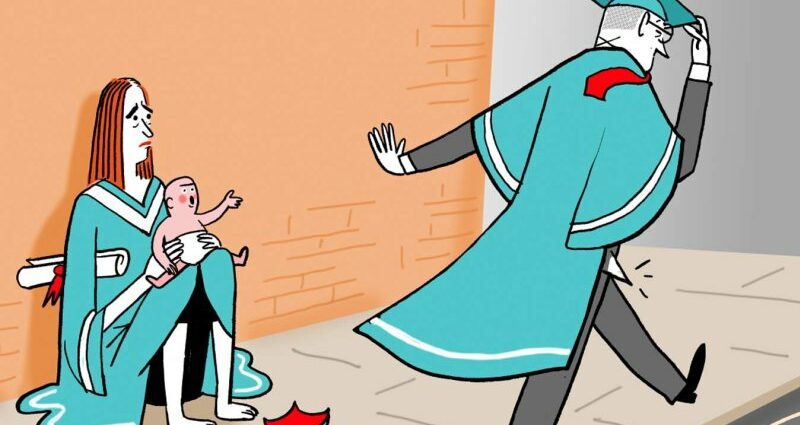If you believe what you see in the media, our youth are groaning under the weight of debt they’ve acquired under the Higher Education Loan Program (HELP), alias the Higher Education Contribution Scheme (HECS). But I don’t believe every sob story I hear. Soft heart, hard head is my motto.
The latest is an ABC report claiming HELP debt has helped entrench women’s economic disadvantage. And the Futurity Investment Group’s latest University Debt Report, released on Wednesday, claims to reveal “the long-term financial and social burden the cost of a university education is having”.
Illustration by Simon LetchCredit:
As I’ve written recently, Baby Boomers are leaving a terrible legacy for the rising generation: climate change, unaffordable home ownership, precarious employment and tax breaks reserved for the old.
I suppose that, to many youths, adding a HELP debt to all that seems like adding insult to injury. But really, compared with that catalogue, student debt is well down the list.
According to the ABC’s report, women say they are frustrated by the HELP debt system and feel disadvantaged. It claims graduates today “often look like” a woman who, having had her children and approaching her 40s, retrained as a teacher.
Seven years later and working part-time, she’s frustrated because, despite paying back $6000 on her debt, she’s only $2000 ahead of where she started. Another woman fears she’ll end up living in her car.
The report says women hold the majority of all student debt, and claims “researchers say the student debt system has exacerbated structural financial inequities between men and women”.
This is a reference to a paper by Mark Warburton of the University of Melbourne. But his message is more nuanced, saying student debt has “become unfair for women, but there is a way to fix this”.
Considering that more girls than boys go on to uni, it’s no surprise that women hold the majority of student debt – even if, on average, men’s debts are greater than women’s.
Women take longer to repay their debt, but this is actually a feature of the scheme that adds to its fairness.
The student loan system was introduced in 1989 so taxpayers could afford to offer higher education to many more young people.Credit:Oscar Colman
According to the Futurity Investment Group’s survey of about 1000 people who attended uni, student debt is pretty much the source of all social evil.
We’re told that three-in-five respondents say their student debt has affected their ability to buy a home. One in three say it has had a “moderate to very large” effect on their ability to start a family. A slightly smaller proportion say it’s affected their ability to get married. (Maybe they mean afford a big-budget wedding.)
A bit under a third of respondents say it’s had a “moderate to very large” effect on their ability to change jobs.
Sorry, but my bulldust detector is pinging like crazy. I just don’t believe it. I’m always sceptical of the results of small-sample surveys sponsored by vested interests, with the results just happening to endorse the outfit’s sales pitch.
Speaking of which, the Futurity Investment Group sells a range of “education bonds” which “allow parents and grandparents to tax-effectively save and invest to accumulate the funding to support their family’s life-long education objectives”.
I suspect that a lot of the resentment of HELP debt stems from a self-serving belief that university education should be free, as it was for a relatively brief period under the Whitlam government.
But that was when less than the top 10 per cent of school-leavers went on to uni. Today, it’s 40 per cent. And, as Warburton reminds us, the student loan system was introduced in 1989 so taxpayers could afford to offer higher education to many more young people.
The scheme was carefully designed – by Professor Bruce Chapman, of the Australian National University – to allow universities to charge tuition fees without discouraging bright kids from poor families from seeking to better themselves.
To this end, the government would lend people the fee-money up front, which they’d have to start repaying only once they were earning the average wage. If you lost your job, the repayments would stop until you got back on your feet.
The government would index your outstanding debt to the inflation rate but, unlike every commercial loan you’ll ever get, it won’t charge you a “real” interest rate of several percentage points on top of the inflation rate.
This is why it’s a good thing, not a bad thing, that women (and men) working only part-time are given longer to repay. A commercial bank wouldn’t do you the favour. And since the whole basis of the scheme is that if you can’t afford to repay the loan, you don’t have to, people need to learn not to worry about student debt the way you should about normal debt. It’s a very different animal.
Even so, in recent years the Coalition tightened up the repayment arrangements in ways that make the scheme less fair, particularly for those working part-time. But, as Warburton says, Labor can fix this.
Ross Gittins unpacks the economy in an exclusive subscriber-only newsletter every Tuesday evening. Sign up to receive it here.
Most Viewed in Business
From our partners
Source: Read Full Article



